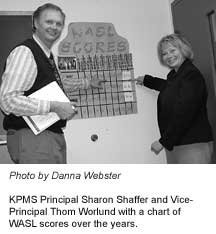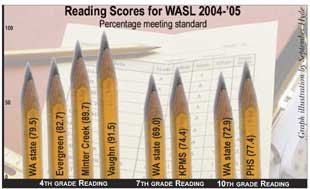Editor's note: This is part one of a two-part series on Washington Assessment of Student Learning. Read part two here.
What’s the WASL? (Circle the correct answer).
An enemy
An opportunity
All of the above
None of the above.
 The WASL is not a test of right and wrong answers, true or false, multiple-choice. It is a test of student performance. The reading test may require comparison and contrast skills to examine complex paragraphs. In writing, students are evaluated on how they construct paragraphs for essays. In math, students must know which applications are correct to use; and in science, students are not asked for memorized classifications of plants and animals, but rather, they must demonstrate the application of the scientific method.
The WASL is not a test of right and wrong answers, true or false, multiple-choice. It is a test of student performance. The reading test may require comparison and contrast skills to examine complex paragraphs. In writing, students are evaluated on how they construct paragraphs for essays. In math, students must know which applications are correct to use; and in science, students are not asked for memorized classifications of plants and animals, but rather, they must demonstrate the application of the scientific method.
But the WASL is much more than a way to measure student performance. The standardized test, mandated by the state Legislature in 1998, is necessary for high school students to receive their diploma, starting with the class of 2008. For school districts, it is a measure of whether they meet federal mandates under the No Child Left Behind Act signed by President Bush in 2002.
In 2005, Peninsula School District (PSD) ranked No. 1 in Pierce County and achieved some of the highest scores in the state on the WASL. Reading scores in fourth, seventh and tenth grades were 82.9 percent proficient, compared to the state average of 73.8 percent.
PSD is dedicated to high performance scores on the WASL, according to Assistant Superintendent Bob Connelly. But, as Connelly focuses his attention on a chart showing 11.7 percent of fourth graders not proficient in reading, he says the district must now target the non-proficient students.
“From the school district’s standpoint, we’re very proud of teachers in the district and their work to provide students to be successful on the WASL,” Connelly says.
But the bar has been raised. “It’s no longer the challenge to get most kids to standard,” he says, “it is…to get all kids to standard.”
 Getting 80 percent of PSD students to standard was no easy task. It took nearly a decade of staff development, curriculum revision and acquiring support programs, Connelly says. In addition, there was public resistance to the WASL to overcome; while the Office of Superintendent of Public Instruction (OSPI) applied pressure for proficiency.
Getting 80 percent of PSD students to standard was no easy task. It took nearly a decade of staff development, curriculum revision and acquiring support programs, Connelly says. In addition, there was public resistance to the WASL to overcome; while the Office of Superintendent of Public Instruction (OSPI) applied pressure for proficiency.
One of the schools that felt the pressure was the middle school on the Key Peninsula. The school’s scores were low in 1998. Reading scores in the building were only 45.7 percent proficient and math scores were at 19.7 percent.
Sharon Shaffer is the new principal at Key Peninsula Middle School. Behind her office door, a chart hangs on the wall. It shows the percent of students who passed the WASL each year for the past eight years of testing. On the chart, reading scores climb from 45.7 percent to 74.4 percent and math scores climb from 19.7 percent to 50.3 percent from 1998 to 2005. When asked if the scores are indications that teachers teach to the test at KPMS, both Shaffer and Vice Principal Thom Worlund reply, “Yes, of course.”
The WASL “is about what we teach at the school,” says Shaffer. The scores are school scores. They are a “measure on how we are doing on standards,” she says.
Shaffer and Worlund explain that the WASL is a test of student performance. Students are expected to know what is taught, to practice what they learn, and to perform at a passing level.
According to Shaffer and Worlund, standards’ testing has brought a transformation to all public schools over the past 10 to 15 years. They compare their building’s education program to a business model. The targets are clear and instruction is aligned to reach them. The WASL scores are about “how we serve the public — how we do business; and we do it much better than we used to,” Shaffer says.
KPMS score improvements reflect a strong supportive structure composed of staff, volunteers, students and families. Shaffer especially appreciates the KP families. She has worked in three middle schools in the district and the “parents out here are incredible,” she says.
The staff, volunteers and students are a team that has been well-supported by materials and resources from the district, according to Worlund. “And that’s why I love working in this district,” he says, “…huge support.”
The chart on the wall is viewed as a work of art, a masterpiece illustrating the many support structures that served to build success on the WASL at KPMS. The school’s success was even noted by state officials: Superintendent of Public School Terri Bergeson chose KPMS as one of three middle schools across the state in her “Student Success 2005 report” highlighting year 2005 WASL achievements.
“We know we are impacting a greater number of kids over time — no matter how they come to us,” Shaffer says.
When the staff saw the scores on this chart, there were “actual tears in the eyes of some teachers,” according to Worlund.
Worlund is convinced that teaching to the WASL prepares students for an “information-rich world where they have to make decisions and where they have to make choices.”
The WASL meets the needs of today’s students who must use their skills to “understand and think — to be critical about the information they are going to be flooded with throughout their life,” he believes.
“(The WASL has) such a good impact on kids and the region,” says Worlund. “To have it go away would be the worst thing to happen in public education.”
The PSD administration agrees. The WASL is seen as an opportunity for both students and the school district to take a regular checkup on where things may stand when the students venture out into competition with the citizens of other nations.
Connelly says passing the WASL assures students they are “learning to be successful — to perform to standard with all kids across the nation — To be able to compete equally.”
The WASL “equals the playing field,” he says.
Special thanks to Keith Stiles, past-president of PSD Board of Directors 1993 to 1995, and KGHP radio (89.9 FM) founder and Saturday morning disk jockey, for his contributions to the story.
UNDERWRITTEN BY THE FUND FOR NONPROFIT NEWS (NEWSMATCH) AT THE MIAMI FOUNDATION, THE ANGEL GUILD, ADVERTISERS, DONORS AND PEOPLE WHO SUPPORT INDEPENDENT, NONPROFIT LOCAL NEWS